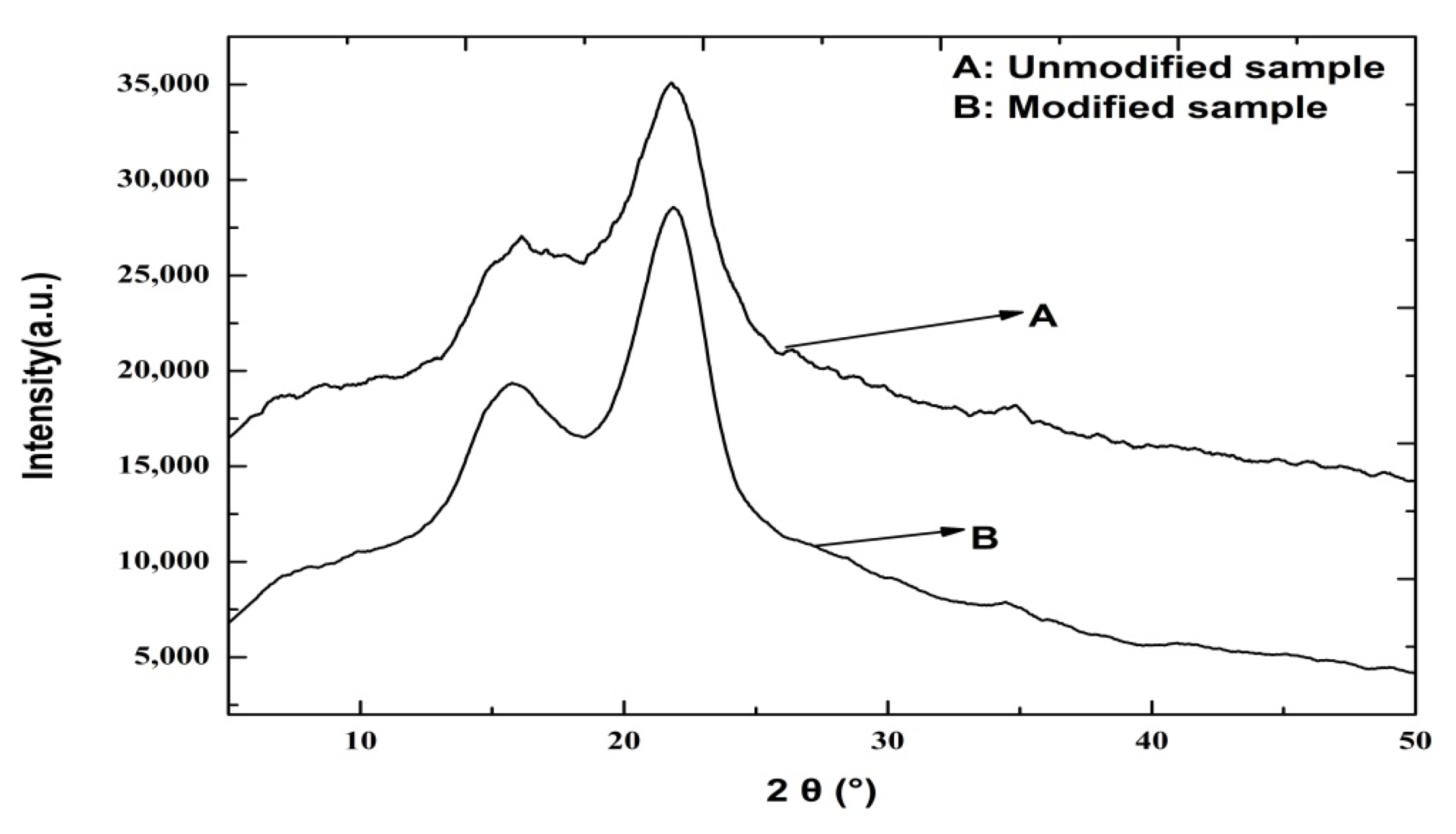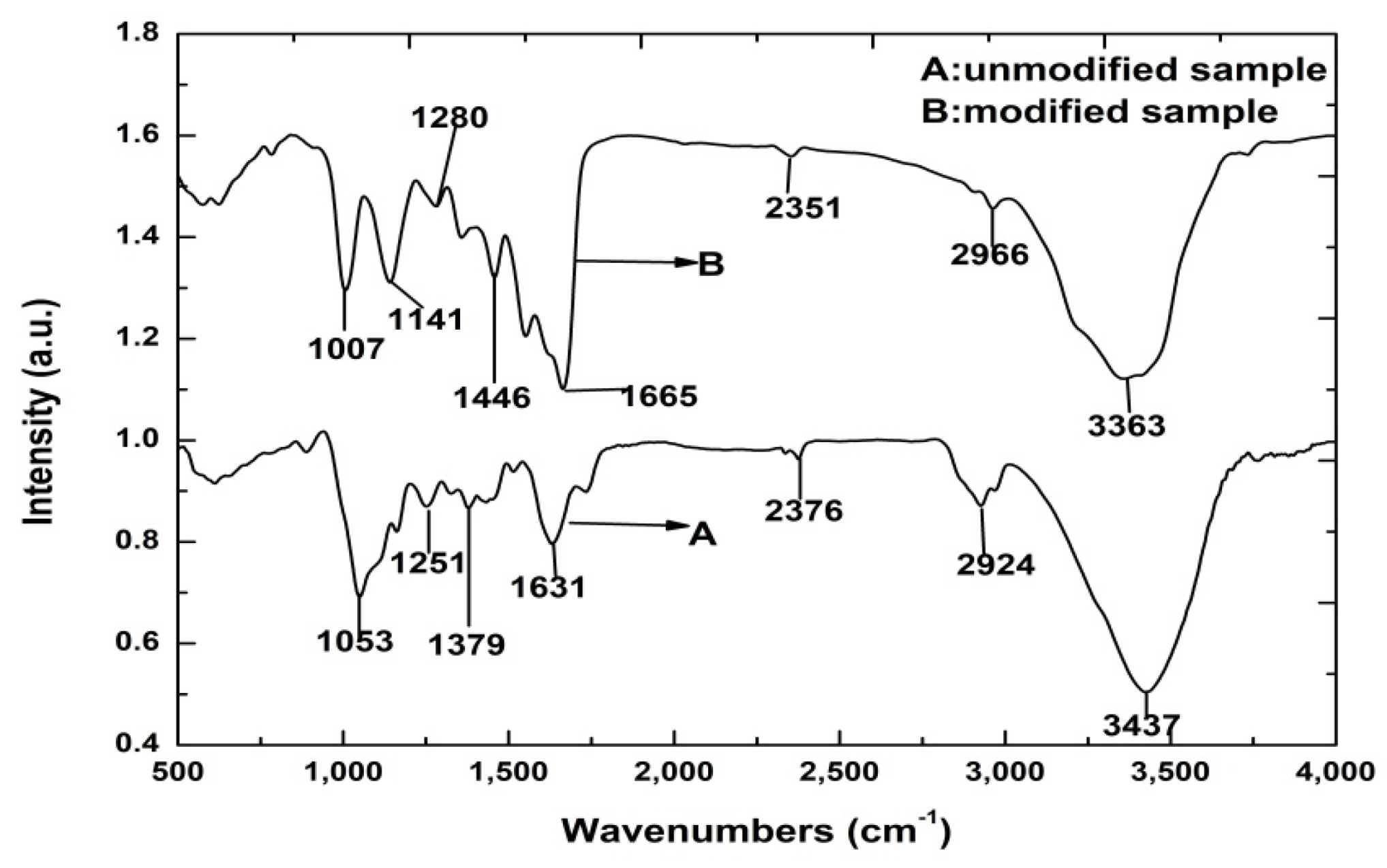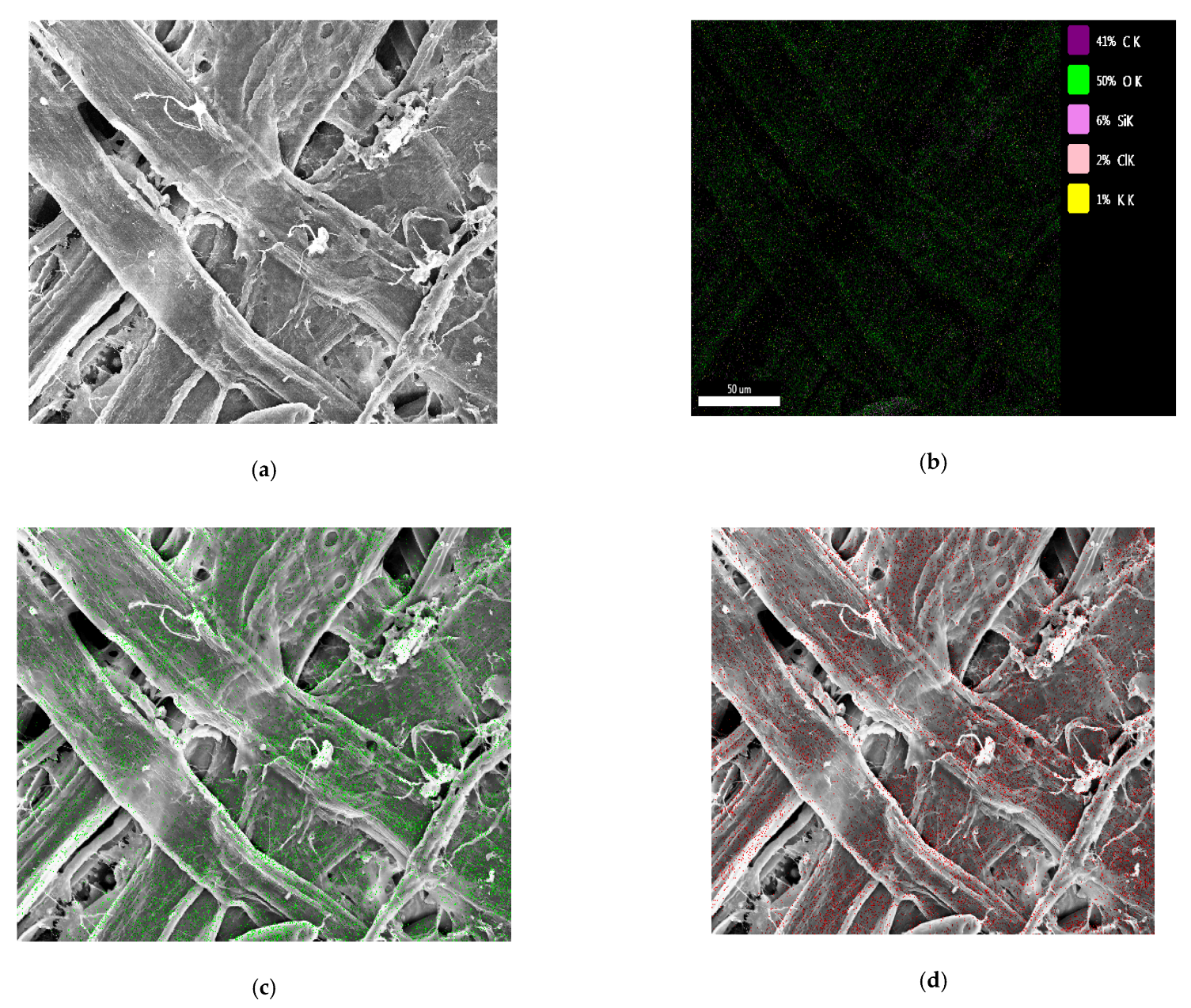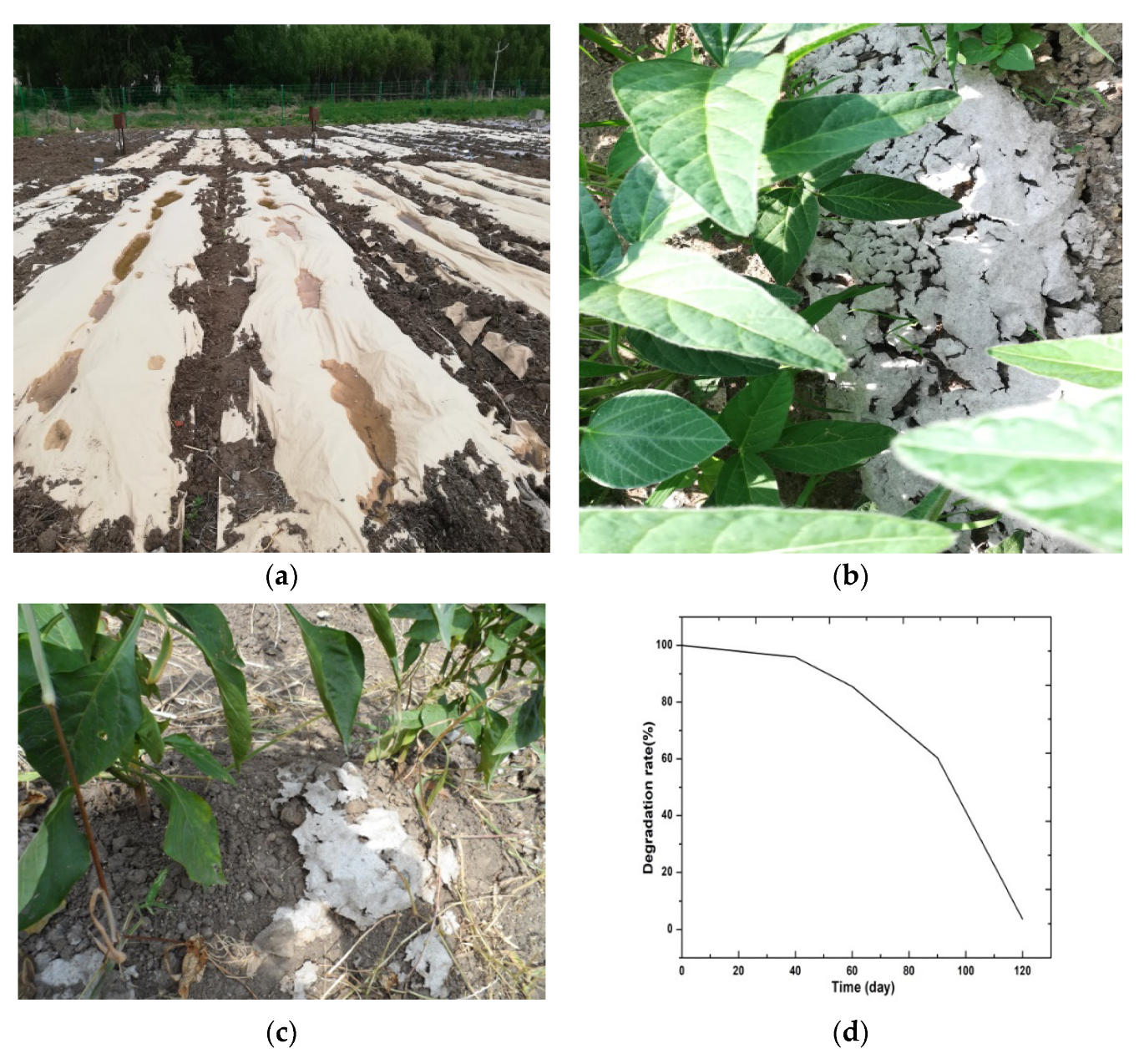Fabrication and Characterization of Degradable Crop-Straw-Fiber Composite Film Using In Situ Polymerization with Melamine–Urea–Formaldehyde Prepolymer for Agricultural Film Mulching
Abstract
:1. Introduction
2. Materials and Methods
2.1. Materials
2.2. Chemicals
2.3. Synthesis of the Melamine–Urea–Formaldehyde Prepolymer Modifier
2.4. Preparation of the Melamine–Urea–Formaldehyde Prepolymer Straw Fiber Composite Films
2.5. Degradability Experiment
2.6. Straw Fiber Film Characterization
2.6.1. Mechanical Properties
2.6.2. Contact Angle Measurement
2.6.3. XRD Analysis
2.6.4. Thermogravimetric Analysis
2.6.5. Fourier Transform Infrared Spectroscopy
2.6.6. Morphology Observation
3. Results and Discussion
3.1. Mechanical Properties of the Straw Fiber Film
3.2. Contact Angle Measurement
3.3. XRD Analysis
3.4. Thermal Properties of the Straw Fiber Composite Film
3.5. Fourier Transform Infrared Spectra Analysis
3.6. Scanning Electron Microscopy Analysis
3.7. Energy-Dispersive X-ray Spectroscopy
3.8. Degradability of the Modified Straw Fiber Film
4. Conclusions
Author Contributions
Funding
Institutional Review Board Statement
Data Availability Statement
Acknowledgments
Conflicts of Interest
References
- Borrowman, C.K.; Johnston, P.; Adhikari, R.; Saito, K.; Patti, A.F. Environmental degradation and efficacy of a sprayable, biodegradable polymeric mulch. Polym. Degrad. Stab. 2020, 175, 109126. [Google Scholar] [CrossRef]
- Gu, X.; Cai, H.; Fang, H.; Li, Y.; Chen, P.; Li, Y. Effects of degradable film mulching on crop yield and water use efficiency in China: A meta-analysis. Soil Tillage Res. 2020, 202, 104676. [Google Scholar] [CrossRef]
- La Mantia, F.P.; Ascione, L.; Mistretta, M.C.; Rapisarda, M.; Rizzarelli, P. Comparative investigation on the soil burial degradation behaviour of polymer films for agriculture before and after photo-oxidation. Polymers 2020, 12, 753. [Google Scholar] [CrossRef] [Green Version]
- Ghimire, S.; Scheenstra, E.; Miles, C.A. Soil-biodegradable mulches for growth, yield, and quality of sweet corn in a Mediterranean-type climate. Hortscience 2020, 55, 317–325. [Google Scholar] [CrossRef] [Green Version]
- Steinmetz, Z.; Wollmann, C.; Schaefer, M.; Buchmann, C.; David, J.; Tröger, J.; Schaumann, G.E. Plastic mulching in agriculture. Trading short-term agronomic benefits for long-term soil degradation? Sci. Total Environ. 2016, 550, 690–705. [Google Scholar] [CrossRef]
- Huang, Y.; Liu, Q.; Jia, W.; Yan, C.; Wang, J. Agricultural plastic mulching as a source of microplastics in the terrestrial environment. Environ. Pollut. 2020, 260, 114096. [Google Scholar] [CrossRef]
- Fang, H.; Li, Y.; Gu, X.; Yu, M.; Du, Y.; Chen, P.; Li, Y. Evapotranspiration partitioning, water use efficiency, and maize yield under different film mulching and nitrogen application in northwest China. Field Crops Res. 2021, 264, 108103. [Google Scholar] [CrossRef]
- Nelson, T.F.; Remke, S.C.; Kohler, H.P.E.; McNeill, K.; Sander, M. Quantification of synthetic polyesters from biodegradable mulch films in soils. Environ. Sci. Technol. 2019, 54, 266–275. [Google Scholar] [CrossRef]
- Halley, P.; Rutgers, R.; Coombs, S.; Kettels, J.; Gralton, J.; Christie, G.; Lonergan, G. Developing biodegradable mulch films from starch-based polymers. Starch-Stärke 2001, 53, 362–367. [Google Scholar] [CrossRef]
- Espi, E.; Salmeron, A.; Fontecha, A.; García, Y.; Real, A.I. Plastic films for agricultural applications. J. Plast. Film. Sheeting 2006, 22, 85–102. [Google Scholar] [CrossRef]
- Liu, E.K.; He, W.Q.; Yan, C.R. ‘White revolution’to ‘white pollution’-agricultural plastic film mulch in China. Environ. Res. Lett. 2014, 9, 91001. [Google Scholar] [CrossRef] [Green Version]
- Luo, C.L.; Zhang, X.F.; Duan, H.X.; Mburu, D.M.; Ren, H.X.; Kavagi, L.; Xiong, Y.C. Dual plastic film and straw mulching boosts wheat productivity and soil quality under the El Nino in semiarid Kenya. Sci. Total Environ. 2020, 738, 139808. [Google Scholar] [CrossRef]
- Latifmanesh, H.; Deng, A.; Li, L.; Chen, Z.; Zheng, Y.; Bao, X.; Zhang, W. How incorporation depth of corn straw affects straw decomposition rate and CN release in the wheat-corn cropping system. Agric. Ecosyst. Environ. 2020, 300, 107000. [Google Scholar] [CrossRef]
- Alemdar, A.; Sain, M. Isolation and characterization of nanofibers from agricultural residues-Wheat straw and soy hulls. Bioresour. Technol. 2008, 99, 1664–1671. [Google Scholar] [CrossRef]
- Demirbas, A. Progress and recent trends in biofuels. Prog. Energy Combust. Sci. 2007, 33, 1–18. [Google Scholar] [CrossRef]
- Liu, J.; Yue, K.; Xu, L.; Wu, J.; Chen, Z.; Wang, L.; Lu, W. Bonding performance of melamine-urea–formaldehyde and phenol-resorcinol–formaldehyde adhesive glulams at elevated temperatures. Int. J. Adhes. Adhes. 2020, 98, 102500. [Google Scholar] [CrossRef]
- Ranjbaran, S.; Nazerian, M.; Kermanian, H.; Koosha, M.; Garmaroody, E.R. High strength papers impregnated with urea/melamine formaldehyde resin/nanosilica nanocomposite coatings: The effects of paper type, blend ratio and nano-content. Mater. Today Commun. 2020, 25, 101300. [Google Scholar] [CrossRef]
- Hasan, K.F.; Horváth, P.G.; Bak, M.; Le, D.H.A.; Mucsi, Z.M.; Alpár, T. Rice straw and energy reed fibers reinforced phenol formaldehyde resin polymeric biocomposites. Cellulose 2021, 28, 7859–7875. [Google Scholar] [CrossRef]
- Makovicka Osvaldova, L.; Markova, I.; Jochim, S.; Bares, J. Experimental Study of Straw-Based Eco-Panel Using a Small Ignition Initiator. Polymers 2021, 13, 1344. [Google Scholar] [CrossRef]
- Viel, M.; Collet, F.; Lanos, C. Development and characterization of thermal insulation materials from renewable resources. Constr. Build. Mater. 2019, 214, 685–697. [Google Scholar] [CrossRef]
- Gillela, S.; Yadav, S.M.; Sihag, K.; Lubis, M.A.R.; Wibowo, E.S.; Negi, A.; Iswanto, A.H.; Antov, P.; Kristak, L. A review on Lantana camara lignocellulose fiber-reinforced polymer composites. Biomass Convers. Biorefin. 2022, 1–19. [Google Scholar] [CrossRef]
- Qi, R.; Jones, D.L.; Li, Z.; Liu, Q.; Yan, C. Behavior of microplastics and plastic film residues in the soil environment: A critical review. Sci. Total Environ. 2020, 703, 134722. [Google Scholar] [CrossRef]
- Hasan, K.M.; Horváth, P.G.; Kóczán, Z.; Le, D.H.A.; Bak, M.; Bejó, L.; Alpár, T. Novel insulation panels development from multilayered coir short and long fiber reinforced phenol formaldehyde polymeric biocomposites. J. Polym. Res. 2021, 28, 467. [Google Scholar] [CrossRef]
- Ong, H.R.; Prasad, R.; Rahman Khan, M.; Chowdhury, M.; Kabir, N. Effect of palm kernel meal as melamine urea formaldehyde adhesive extender for plywood application: Using a Fourier transform infrared spectroscopy (FTIR) study. Appl. Mech. Mater. 2012, 121, 493–498. [Google Scholar] [CrossRef]
- Alexander, L. X-ray diffraction methods in polymer science. J. Mater. Sci. 1971, 6, 93. [Google Scholar] [CrossRef]
- Lang, Q.; She, Y.; Chen, H.Y.; Pu, J.W. Poplar wood-methylolurea composites prepared by in situ polymerization. J. Appl. Polym. Sci. 2013, 130, 933–938. [Google Scholar] [CrossRef]
- Snyder, K.; Grant, A.; Murray, C.; Wolff, B. The effects of plastic mulch systems on soil temperature and moisture in central Ontario. HortTechnology 2015, 25, 162–170. [Google Scholar] [CrossRef] [Green Version]
- Ma, D.; Chen, L.; Qu, H.; Wang, Y.; Misselbrook, T.; Jiang, R. Impacts of plastic film mulching on crop yields, soil water, nitrate, and organic carbon in Northwestern China: A meta-analysis. Agric. Water Manag. 2018, 202, 166–173. [Google Scholar] [CrossRef]
- Bandopadhyay, S.; Martin-Closas, L.; Pelacho, A.M.; DeBruyn, J.M. Biodegradable plastic mulch films: Impacts on soil microbial communities and ecosystem functions. Front. Microbiol. 2018, 9, 819. [Google Scholar] [CrossRef] [Green Version]
- Lang, Q.; Zeng, B.; Miao, X.W.; Xue, Z.; Pu, J.W. Effect of urea-formaldehyde prepolymer on fast-growing wood. Wood Res. 2013, 58, 191–200. [Google Scholar]
- Yu, L.Y.; Xu, Z.L.; Shen, H.M.; Yang, H. Preparation and characterization of PVDF–SiO2 composite hollow fiber UF membrane by sol-gel method. J. Membr. Sci. 2009, 337, 257–265. [Google Scholar] [CrossRef]
- He, Y.; Pang, Y.; Liu, Y.; Li, X.; Wang, K. Physicochemical characterization of rice straw pretreated with sodium hydroxide in the solid state for enhancing biogas production. Energy Fuels 2008, 22, 2775–2781. [Google Scholar] [CrossRef]
- GB/T 2793-1995; Test Method for Nonvolatile Content of Adhesives. Chinese Standard: Beijing, China, 1995.
- GB/T GB/T 5544-1985; Resin Finishing Agent-Determination of Free Formaldehyde Content. Chinese Standard: Beijing, China, 1985.
- GB/T 7981-1987; Pulps-Preparation of Laboratory Sheets: Conventional Sheet-Former Method. Chinese Standard: Beijing, China, 1987.
- GB 12914-2008; Paper and Board-Determination of Tensile Properties with Constant Rate of Loading Approach. Chinese Standard: Beijing, China, 2008.
- Liu, C.F.; Xu, F.; Sun, J.X.; Ren, J.L.; Curling, S.; Sun, R.C.; Baird, M.S. Physicochemical characterization of cellulose from perennial ryegrass leaves (Lolium perenne). Carbohydr. Res. 2006, 341, 2677–2687. [Google Scholar] [CrossRef] [PubMed]
- Liu, R.; Yu, H.; Huang, Y. Structure and morphology of cellulose in wheat straw. Cellulose 2005, 12, 25–34. [Google Scholar] [CrossRef]
- Satapathy, S.; Prasad, E. Charge transfer modulated self-assembly in poly (aryl ether) dendron derivatives with improved stability and transport characteristics. ACS Appl. Mater. Interfaces 2016, 8, 26176–26189. [Google Scholar] [CrossRef] [PubMed]
- Satapathy, S.; Prabakaran, P.; Prasad, E. Augmenting photoinduced charge transport in a single-component gel system: Controlled in situ gel-crystal transformation at room temperature. Chem.-A Eur. J. 2018, 24, 6217–6230. [Google Scholar] [CrossRef]
- Kumar, T.S.M.; Rajini, N.; Reddy, K.O.; Rajulu, A.V.; Siengchin, S.; Ayrilmis, N. All-cellulose composite films with cellulose matrix and Napier grass cellulose fibril fillers. Int. J. Biol. Macromol. 2018, 112, 1310–1315. [Google Scholar] [CrossRef] [PubMed]
- Fu, P.; Hu, S.; Xiang, J.; Li, P.; Huang, D.; Jiang, L.; Zhang, J. FTIR study of pyrolysis products evolving from typical agricultural residues. J. Anal. Appl. Pyrolysis 2010, 88, 117–123. [Google Scholar] [CrossRef]
- Frías, M.; Savastano, H.; Villar, E.; de Rojas, M.I.S.; Santos, S. Characterization and properties of blended cement matrices containing activated bamboo leaf wastes. Cem. Concr. Compos. 2012, 34, 1019–1023. [Google Scholar] [CrossRef]
- Abduwaiti, A.; Liu, X.; Yan, C.; Xue, Y.; Jin, T.; Wu, H.; Liu, Q. Testing Biodegradable Films as Alternatives to Plastic-Film Mulching for Enhancing the Yield and Economic Benefits of Processed Tomato in Xinjiang Region. Sustainability 2021, 13, 3093. [Google Scholar] [CrossRef]
- Yu, Q.; Liu, R.; Li, K.; Ma, R. A review of crop straw pretreatment methods for biogas production by anaerobic digestion in China. Renew. Sustain. Energy Rev. 2019, 107, 51–58. [Google Scholar] [CrossRef]
- Alemdar, A.; Sain, M. Biocomposites from wheat straw nanofibers: Morphology, thermal and mechanical properties. Compos. Sci. Technol. 2008, 68, 557–565. [Google Scholar] [CrossRef]
- Chen, X.; Yu, J.; Zhang, Z.; Lu, C. Study on structure and thermal stability properties of cellulose fibers from rice straw. Compos. Sci. Technol. 2011, 85, 245–250. [Google Scholar] [CrossRef]
- Jiao, Y.; Wan, C.; Zhang, W.; Bao, W.; Li, J. Carbon fibers encapsulated with nano-copper: A core-shell structured composite for antibacterial and electromagnetic interference shielding applications. Nanomaterials 2019, 9, 460. [Google Scholar] [CrossRef] [PubMed] [Green Version]
- Wang, J.; Wang, Q.; Wu, Y.; Bai, F.; Wang, H.; Wang, S.S. Preparation of Cellulose Nanofibers from Bagasse by Phosphoric Acid and Hydrogen Peroxide Enables Fibrillation via a Swelling, Hydrolysis, and Oxidation Cooperative Mechanism. Nanomaterials 2020, 10, 2227. [Google Scholar] [CrossRef] [PubMed]








| Name | Density (g/cm3) | pH | Viscosity (mPa s) | Solid Content (%) | Free Formaldehyde Content (mg/100 g) |
|---|---|---|---|---|---|
| MUF | 1.30 | 8.2 | 13 | 59.60 | 0.07 |
| Name | Wheat Straw Pulp (%) | Bleached Softwood Pulp (%) | MUF (%) | Chemical Stability A (%) | Chemical Stability B (%) |
|---|---|---|---|---|---|
| A | 40 | 60 | 0 | 0 | 0 |
| B | 40 | 60 | 5 | 2 | 3 |
| C | 40 | 60 | 10 | 2 | 3 |
| D | 40 | 60 | 15 | 2 | 3 |
| E | 40 | 60 | 20 | 2 | 3 |
| F | 40 | 60 | 25 | 2 | 3 |
| Name | Dry Tensile Stress (N) | Deformation (mm) | Tensile Strength (kN/m) | Tensile Index (N·m/g) | Basis Weight (g/m2) | Breaking Length (mm) |
| A | 35.21 | 1.93 | 2.35 | 39.12 | 60 | 15 |
| B | 40.97 | 1.97 | 2.73 | 45.52 | 60 | 15 |
| C | 43.07 | 1.78 | 2.87 | 47.86 | 60 | 15 |
| D | 55.92 | 2.09 | 3.73 | 62.13 | 60 | 15 |
| E | 62.28 | 2.36 | 4.15 | 69.20 | 60 | 15 |
| F | 57.14 | 3.01 | 3.61 | 60.16 | 60 | 15 |
| Name | Wet Tensile Stress (N) | Deformation (mm) | Tensile Strength (kN/m) | Tensile Index (N·m/g) | Basis weight (g/m2) | Breaking Length (mm) |
| A | 6.09 | 2.51 | 0.41 | 6.77 | 60 | 15 |
| B | 13.25 | 4.12 | 0.88 | 14.72 | 60 | 15 |
| C | 16.96 | 4.96 | 1.13 | 18.84 | 60 | 15 |
| D | 18.88 | 5.27 | 1.26 | 20.98 | 60 | 15 |
| E | 22.70 | 5.34 | 1.51 | 22.13 | 60 | 15 |
| F | 19.78 | 5.15 | 1.32 | 21.98 | 60 | 15 |
Publisher’s Note: MDPI stays neutral with regard to jurisdictional claims in published maps and institutional affiliations. |
© 2022 by the authors. Licensee MDPI, Basel, Switzerland. This article is an open access article distributed under the terms and conditions of the Creative Commons Attribution (CC BY) license (https://creativecommons.org/licenses/by/4.0/).
Share and Cite
Lang, Q.; Liu, C.; Zhu, X.; Zhang, C.; Zhang, S.; Li, L.; Liu, S.; Chen, H. Fabrication and Characterization of Degradable Crop-Straw-Fiber Composite Film Using In Situ Polymerization with Melamine–Urea–Formaldehyde Prepolymer for Agricultural Film Mulching. Materials 2022, 15, 5170. https://doi.org/10.3390/ma15155170
Lang Q, Liu C, Zhu X, Zhang C, Zhang S, Li L, Liu S, Chen H. Fabrication and Characterization of Degradable Crop-Straw-Fiber Composite Film Using In Situ Polymerization with Melamine–Urea–Formaldehyde Prepolymer for Agricultural Film Mulching. Materials. 2022; 15(15):5170. https://doi.org/10.3390/ma15155170
Chicago/Turabian StyleLang, Qian, Chuanhao Liu, Xiaoxin Zhu, Chao Zhang, Shengming Zhang, Longhai Li, Shuang Liu, and Haitao Chen. 2022. "Fabrication and Characterization of Degradable Crop-Straw-Fiber Composite Film Using In Situ Polymerization with Melamine–Urea–Formaldehyde Prepolymer for Agricultural Film Mulching" Materials 15, no. 15: 5170. https://doi.org/10.3390/ma15155170
APA StyleLang, Q., Liu, C., Zhu, X., Zhang, C., Zhang, S., Li, L., Liu, S., & Chen, H. (2022). Fabrication and Characterization of Degradable Crop-Straw-Fiber Composite Film Using In Situ Polymerization with Melamine–Urea–Formaldehyde Prepolymer for Agricultural Film Mulching. Materials, 15(15), 5170. https://doi.org/10.3390/ma15155170







